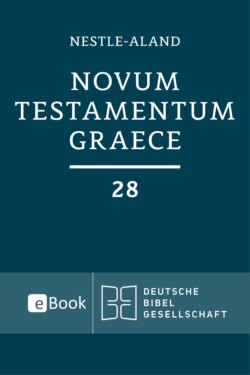Читать книгу Novum Testamentum Graece (Nestle-Aland) - Группа авторов, Nestle-Aland - Страница 43
На сайте Литреса книга снята с продажи.
2.2.2 Defining the Consistently Cited Witnesses for the Catholic Letters
ОглавлениеThe ECM text of the Catholic Letters was established by means of the Coherence-Based Genealogical Method (in what follows “coherence method”).2 One essential concept of this method is that of “potential ancestor”. One of two textual witnesses may be classified as potential ancestor of the other, if it more often supports a variant from which the variant of the other witness can be derived. Some witnesses have many, others have a few or only one potential ancestor. The percentages of agreement between witnesses compared are used to arrange the potential ancestors of a witness in a ranking order, according to their degree of relationship. The method can also be applied to a comparison with the reconstructed initial text. Hence we can say for which manuscript texts the initial text A has the highest rank among their potential ancestors. This is the case, apart from a couple of highly fragmented papyri and majuscules, for the following 18 manuscripts:
ℵ, A, B, C, P, Ψ, 048, 5, 81, 436, 442, 1175, 1243, 1735, 1739, 1852, 2344, 2492.
The text of these manuscripts is more closely related to A than to any manuscript text. 468, an important witness to the 13th century Byzantine text, also ranks among manuscripts of this category. However, as the Byzantine text is very well represented, we selected 307 from the 10th century instead of 468. These are close relatives, but we opted for 307 because its text represents an early branch of the Byzantine tradition which diverges from the mainstream.
For 88 and 1881, A is the most closely related potential ancestor in one writing only, for 88 in the Letter of Jude, for 1881 in the First Letter of John. Consequently they are cited for these texts only.
33 continues to be a consistently cited witness, not because of its relevance for reconstructing the text, but because of its interesting special readings.
1448 and 1611 represent the well-known group of manuscripts transmitting the text translated by Thomas of Harkel in 616.
Finally, 642, a minuscule from the 14th century, was numbered among the consistently cited witnesses because it documents the text of a group of late Byzantine witnesses, a text with several peculiarities. The following members of this group are cited in the ECM: 218, 808, 1127, 1359, 1563, 1718, 2374.
In addition, all the papyri containing the text of the Catholic Letters were included.
| Jak | 20, 23, 54, 74, 100 |
| 1Pt | 72, 74, 81, 125 |
| 2Pt | 72, 74 |
| 1Jh | 9, 74 |
| 2Jh | 74 |
| 3Jh | 74 |
| Jd | 72, 74, 78 |
The Byzantine text is indicated by the sign “Byz” as in the ECM. Consequently the sign was abandoned in the apparatus of the Catholic Letters. In the ECM “Byz” is represented by seven manuscripts containing the Byzantine text in a pure form. The selection of these representatives was optimised for the different texts as they were published, and therefore it changes from letter to letter.3 Where these representatives indicate splits in the Byzantine tradition, the resulting branches are identified as “Byzpt”.4
